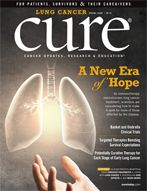Publication
Article
CURE
A Moving Target: Targeted Therapies Boosting Lung Cancer Survival Rates
Author(s):
For some with advanced non-small cell lung cancer, the rapidly growing field of targeted therapies is boosting survival expectations.
Elizabeth Lacasia Photo by Nieshka Rutherford

Elizabeth Lacasia - Photo by Nieshka Rutherford
Elizabeth Lacasia experienced a defining moment the day she found out that her rare form of lung cancer carried the ROS-1 gene alteration. The knowledge, she says, helped her to better understand the stage 4 in situ pulmonaryadenocarcinoma — previously known as bronchioalveolar carcinoma — for which she’s undergone years of treatment due to recurrences. "It was a eureka moment to finally find out which alteration my cancer had, what was driving my disease," says Lacasia, 54. Better yet, Lacasia's genomic status has allowed her to benefit from a targeted drug approved this spring for patients with the ROS-1 alteration.
Xalkori (crizotinib) was initially approved by the U.S. Food and Drug Administration (FDA) to treat patients whose non-small cell lung cancers (NSCLCs) harbor an alteration in a gene called ALK, which occurs in up to 8 percent of patients with the disease. In March, the FDA expanded the use of Xalkori to include lung cancers with a second abnormality, the ROS-1 gene alteration. Lacasia is one of the estimated 1 percent of patients with NSCLC who have the ROS-1 alteration.
After taking traditional treatments in the past, Lacasia says, targeted therapies like Xalkori have allowed her to live a relatively normal life again.
Lacasia started taking Xalkori orally daily over a year ago and currently has no evidence of disease. Her complete response to the drug was even better than that typically seen in a clinical trial of Xalkori, in which nearly 75 percent of patients' tumors had a significant response, but only three of 50 patients had a complete response.The average length of response among those in the trial was about 1.5 years.
ROS-1 is just the most recent of many genetic alterations that scientists have been able to target with drugs. This ongoing discovery of targets is changing the landscape of how patients with advanced NSCLC are treated, and extending the amount of time that they can live with this disease.
In addition to using targeted therapies, doctors apply a variety of other strategies to treat stage 4 NSCLC, including combinations of chemotherapy and radiation; the anti-angiogenic drug Avastin (bevacizumab), which stops blood vessels from growing and feeding tumors; as well as immunotherapy with drugs that inhibit the protein PD-1: Opdivo (nivolumab) and Keytruda (pembrolizumab).
The search for novel therapies is less advanced in small cell lung cancer, for which treatments mainly include surgery, chemotherapy and radiation.
FINDING, AND HITTING, A TARGET
In 40 percent of cases, NSCLC is diagnosed in stage 4, meaning it has metastasized or spread beyond the lung. Patients with stage 4 disease are not candidates for surgery. Instead, the goal of treatment is to extend life and maintain quality of life. At stage 4, the five-year survival rate for patients with NSCLC is about 1 percent. In the past, it was thought that NSCLC, which accounts for between 85 and 90 percent of all lung cancer diagnoses, was one disease, and patients often got one-size-fits-all treatment with chemotherapy, according to Benjamin Levy, medical director of Thoracic Medical Oncology at Mount Sinai Health System.
"What we have come to find out in the last five to 10 years is that NSCLC is not all the same," Levy says. "This cancer can be parsed out into what are called different driver mutations, or genetic alterations that dictate the tumor's behavior."
By identifying these driver mutations within lung cancer, Levy says doctors are not only able to define how a tumor is molecularly characterized, but can now pair some of the most common molecular alterations with drugs that target those mutations.
"When we talk about these mutated genes, these are not genes passed on from someone's parents; they are not hereditary," explains Alice T. Shaw, a thoracic oncologist and associate professor of medicine at the Massachusetts General Hospital. "These are specific changes that have occurred in the DNA of the cancer cell that are now driving its growth."
About one in four patients with lung cancer has a genomic glitch that is potentially targetable with medication, according to Shaw. For now, she says, these targets have been identified almost exclusively within a subset of NSCLC called adenocarcinomas.
"Prior to our understanding of any of these alterations, patients with metastatic lung cancer would live on average 12 months," Shaw says. "Nowadays, these targeted therapies have a huge impact in terms of extending life expectancy and improving quality of life."
EGFR
One of the most commonly occurring mutations in NSCLC is the EGFR mutation, present in about 10 to 15 percent of patients in the United States and Europe. Increased production of EGFR, which stands for epidermal growth factor receptor, signals a tumor to grow better and escape the normal checks and balances that regulate cell survival. Drugs that target EGFR — EGFR inhibitors — slow the growth of the tumor by blocking that signal.
Tarceva (erlotinib), Gilotrif (afatinib) and Iressa (gefitinib) are three drugs approved by the FDA that target EGFR and can be used in patients with NSCLC; most, but not all, of those eligible for the treatment have the non-squamous form of the disease. A patient diagnosed with advanced or metastatic disease that expresses an EGFR mutation will receive one of these drugs in the first-line setting, and most will respond to the drug for about 10 to 12 months and potentially live several years or more, Shaw says.
Unfortunately, cancer treated with these targeted therapies will eventually stop responding to the drug, and will begin to grow again, Levy explains. In some of these cases, a new biopsy — which samples the tumor tissue — may reveal that the cancer has developed a new resistance mutation causing it to no longer respond to EGFR inhibitors.
"We have found that about 60 percent of patients who have relapsed have developed another new mutation in EGFR called T790M," Levy says.
In January, the FDA approved a targeted therapy called Tagrisso (osimertinib) for patients whose lung cancer has the EGFR T790M mutation and whose disease got worse after being treated with an EGFR-targeting drug. Clinical trials of Tagrisso showed that more than 60 percent of patients given the drug had a complete or partial reduction in tumor size.
In separate clinical trials of two other drugs targeting these T790M mutations, rociletinib (CO-1686) and BI-1482694, about 60 percent of patients with the EGFR T790M mutation had tumor response, but both drugs are still awaiting FDA approval. Since those results were first reported, with further analysis, the overall response rate for rociletinib has dropped to around 30 percent, and the FDA, in December 2015, extended its review period on the drug to consider this updated information. Meanwhile, the same month, the FDA granted breakthrough status to BI-1482694, a decision intended to speed up the review process for that drug.
ALK
At age 24, Matthew Hiznay found out that his lung cancer contained a rearrangement in the gene called ALK, and that he, like Lacasia, was a good candidate for Xalkori.
Similar to EGFR mutations, the ALK rearrangement produces a protein that causes cancer cells to grow and spread. ALK rearrangements can also be found in tumors other than lung cancer, including some types of lymphoma and sarcomas.
In many cases, Xalkori, and drugs that target EGFR, treat a more specific population than other lung cancer treatments — young, healthy non-smokers like Hiznay.
"When we think about the (known driver) mutations that occur in lung cancer, we associate them with never- smokers or former smokers, but that is not universally true — they do occur in smokers as well," explains Christine Lovly, assistant professor of medicine at Vanderbilt-Ingram Cancer Center. "However, for never-smokers, we detect lung cancers when patients are in their 40s, 30s or even as young as their 20s, several decades younger than we would think of for standard smoking-related lung cancer."
Hiznay had gone to see a physician after developing a dry cough in the middle of summer. Later, after a swollen lymph node in his neck was removed, his physicians told him they thought he had some form of cancer. Several tests later, Hiznay was diagnosed with stage 4 NSCLC.
Hiznay's physicians sent a sample of his tumor for molecular testing, and he began a two-week wait for the results. During that time, he became very sick and was admitted to the hospital, where he suffered a pulmonary arrest and had to be intubated for three days in order to breathe.
"They were not going to be able to give me chemotherapy while we waited for the test results, because I was too sick," Hiznay recalls. "Waiting for the results to see if I could get the targeted therapy was really my last chance at taking the disease out."
In early September 2011, Hiznay learned of the ALK rearrangement in his tumor, and the next day he began Xalkori. The drug had been approved just nine days after he was diagnosed with lung cancer.
"Within 11 days, the cancer had started clearing up, and two months after starting it, the cancer was in remission," Hiznay says.
As expected, Hiznay's cancer ultimately developed a resistance to Xalkori. In 2012, he enrolled in a clinical trial of another ALK-targeting drug, LDK378, which was approved in April 2014 as Zykadia (ceritinib) for patients who progress on Xalkori.
Although Zykadia helped to control his disease for several months, it began to grow again, and Hiznay started a more traditional course of chemotherapy and radiation to help keep the cancer's growth under control.
In March 2015, he enrolled in a trial of an experimental targeted therapy, lorlatinib (PF-06463922), which is designed to target the ALK rearrangement as well as ROS-1 rearrangements. Hiznay’s cancer again went into remission in July 2015, and now, as he approaches the five-year anniversary of his diagnosis this August, he continues to show no signs of progression.
In addition to Xalkori and Zykadia, a third ALK-targeting drug, Alecensa (alectinib), was approved in December to treat ALK-positive NSCLC that has progressed after treatment with Xalkori.
QUALITY OF LIFE
Lacasia and Hiznay can both compare the ravaging side effects of chemotherapy and radiation with those of the newer targeted therapies.
In the months ahead of and during his wedding, Hiznay underwent chemotherapy and radiation to his neck, upper chest and armpit, treatments he describes as "brutal." The radiation, in combination with the cancer itself and repeated testing, ultimately cost him the use of one of his arms, a very unusual outcome.
His left neck/shoulder area, the site of his cancer's metastasis when he was diagnosed, has weathered three biopsies, and radiation caused further problems by damaging the brachial plexus, a grouping of nerves that control muscular and vascular function in the same region, Hiznay explains.
Similarly, Lacasia describes her time on chemotherapy as leaving her with almost no quality of life.
"I could go on walks, but only slowly. I spent most of my time just trying to be comfortable," says Lacasia, who has developed a patient-to-patient website, LungPedia.com, that contains anecdotal advice on how to deal with the side effects of lung cancer treatment.
As a rule, targeted therapies seem to be much better tolerated than chemotherapy, Levy says. The most common side effects of EGFR-targeted therapies are rash and diarrhea. For ALK therapies, there are different side effects that include nausea, as well as liver function and vision abnormalities, but generally, all of these can be managed.
"When we think about targeted therapy, we often think about the scientific side, the rationale to target the gene, but another big side is the quality-of-life benefits they give to patients," Lovly adds. "For patients receiving standard chemotherapy, they have to be in the infusion room up to eight hours, compared with targeted therapy, where they are taking a pill at home. That is a huge issue, especially for patients with advanced-stage disease who may have a limited life span. Every moment spent with family or doing things they enjoy is important."
WHOM TO TEST AND WHEN
According to Levy, every person diagnosed with advanced non-squamous NSCLC should have molecular testing done for genetic alterations. When and how this testing occurs, though, still varies from institution to institution. "The testing is most commonly next-generation sequencing, but some institutions are testing for only a few genes, some are doing a 50-gene panel and some are testing for 300 genes," Levy says.
"At the minimum, every lung cancer should be tested for EGFR, ALK and ROS-1, because there are FDA-approved drugs for those indications in lung cancer," Lovly adds.
Although there are targeted therapies available for only three mutations, there is ongoing research into many of the other molecular abnormalities seen in NSCLC. For example, about 25 percent of patients with NSCLC have a mutation in the KRAS gene, but there is currently no therapy that can successfully target KRAS. Unlike EGFR, ALK and ROS-1, KRAS mutations are more commonly seen in patients with a history of smoking.
Other driver mutations found in less than 5 percent of patients with NSCLC affect levels of the protein HER2, also a common problem in breast cancer; the BRAF gene, sometimes also abnormal in melanoma; the RET gene; and a variety of others.
"We have many targeted therapies coming down the pike that may eventually receive FDA approval," Levy says. "With something like HER2, you intuitively think that we could use the same treatment used in breast cancer to target it, but it does not work that way. It is more complicated."
Additionally, targeted therapies are only the standard of care in patients with stage 4 disease. However, clinical trials are looking at their use in patients with earlier-stage disease, Lovly notes.
"With these targeted therapies, it seems like the sky is the limit. If patients are not doing well with one drug, there are other drugs approved," Levy says. "When a patient is diagnosed, they often want to know what their survival is (going to be), but now, if you have a target, we don't know anymore. Things are moving so quickly it is hard to say how many new targeted drugs will be approved."






